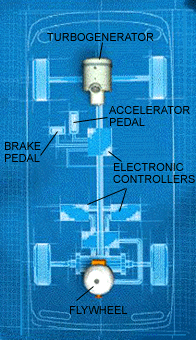|
|
 |
Another alternative to the hybrid vehicle is adding a flywheel. This
design includes a flywheel and a gas-turbine engine similar to a small
jet engine. Both the flywheel and the turbine have generators attached
to them which combined are more efficient and powerful than an internal
combustion engine. The turbine supplies power for cruising while
the flywheel is used for bursts of acceleration. While cruising,
the turbine keeps the flywheel rotating and provides power to the motor.
During braking the flywheel is able to regain some lost energy.
The flywheel concept is simply Newton's Second Law or the Law of Conservation of Angular Momentum. Starting with F = dP / dt We get L = r x P or L = rmvtheta From this last equation you can see that the energy stored on the flywheel is dependent on the rotational velocity of the flywheel, since the mass and position vector are not variable. Therefore, the faster the flywheel spins, the more energy you can divert to your vehicle without totally depleting it. This concept has proven more difficult to deploy than had originally been thought. The first prototype was tested on January 5, 1997. The plan for the near future is to put the hybrid powertrain into a converted luxury sports sedan to demonstrate the acceleration, fuel economy, and low emissions. |